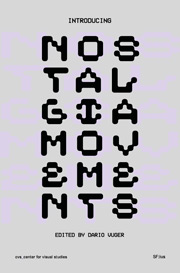Publications
New Edition of the CVS and SF:ius: Introducing Nostalgia Movements
This volume, edited by Dario Vuger, presents a psychogeographical outline of an effort to critically engage the phenomena of nostalgia in everyday life as we experience it today. From essays, interviews, and research to aesthetic renderings and artistic reactions, the volume aims to demonstrate the scopes of nostalgia's influence on contemporary culture as a state of being, feeling, and as an attitude provoked by the techno-scientific developments of the late 20th and first two decades of 21st century. Not being a simple introduction, this book does not contain a concise history of nostalgia, and beyond its perspective as an academic resource – as a contribution to an ever–growing field of nostalgia research – one of its primary goals is to provide the reader with the propaedeutic for practical engagement with the phenomena of nostalgia there where its effects are most observable in popular culture of our time. More
The first section of the volume introduces us to the topic through several interviews and essays which bring forth the aesthesis and intellectual curiosity surrounding the phenomena of nostalgia. The ideogram assigned to this chapter suggests we are only "loading the tape" or feeding our interest in the topic which will be further extended in the 'play' section where two additional texts are introduced: one impressionist and sentimental in character, highlighting nostalgia as a driving force as well as a subject of mindful philosophical reflection, and the other a seminal exploration of nostalgia through the work of one of the central figures in the aesthetic thought of the 20th century.
We would then proceed to "pause", reflect and examine the ways in which nostalgia is grasped academically, how it appears as an implicit or explicit motif in popular culture and art of the 20th century and thus bring us to the largest section of this volume. There we are going to "rewind" and turn from our global circumscribing of nostalgia towards the more particular studies which might at first appear local in character. However, exploring these topics will help us reveal the variety of ways in which nostalgia invades our culture as a whole and thus also suggest the ways in which we ourselves can practise recognizing nostalgic effects and symptoms in our own immediate or virtual surroundings. It so happens that the geo-political situation – historic and contemporary – in Croatia, former state of the Socialist Federal Republic of Yugoslavia proves to be an important area for the study of nostalgia in more than just local context. Political structures, economic models, artistic and cultural production of one bygone era continues to live not only in our memories but also in archives – personal and collective – which are subject to digitalization, virtualization and visualisation in the digital world, reshaping our knowledge of the past while at the same time implementing these pasts to be a part of our living present.
Fast forwarding to the present times, the final section explores the concrete artistic practices that build on the psychogeographic foundations we were able only to sketch out in the previous section. This chapter only ads to our conceptual mapping not only by showcasing the works of artists who participated in the conference exhibition but also by adding several others note-worthy contributions, one exhibition catalogue, an interview and a short sketching of one ephemeral attempt to "hack" nostalgia as a conclusion to the whole volume.
In the end, we hit "record" in order to recapitulate, list out and briefly outline the contributions to this volume, mention all the authors and artists, collect the bibliography and suggest the literature which could in the opinion of the editor be beneficial not only for future researchers of nostalgia but anyone interested in rethinking contemporary culture from the standpoint of methodologies suggested in this book. Introducing Nostalgia Movements is conceptually composed as a workbook, and its intentions are modest, environmental in character – as the title '"Introducing..." suggests – and in no way definitive for the subject. The composition suggests how one should proceed in grasping any contemporary phenomena while the contents of the book show the variety of expressions available to fill in such a composition. Through such an engagement with this collection of intellectual and artistic artefacts one might discover (and continue discovering) nostalgia as a true metaphor of our time.
 The publication in PDF (14.8 MB)
The publication in PDF (14.8 MB)
Dario Vuger, PhD is a curator at the Museum of Fine Arts in Osijek, Croatia, teaching assistant at the Academy of Arts and Culture in Osijek, researcher and lecturer in contemporary philosophy, aesthetics and theory of art. He is a member of Central and East European Society for Phenomenology (CEESP) and International Media and Nostalgia Network (imnn).
